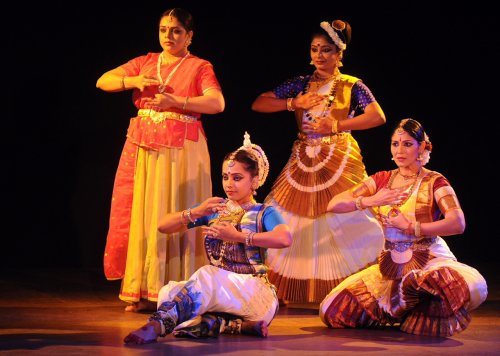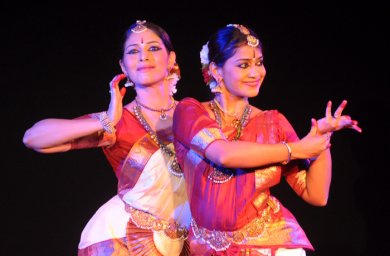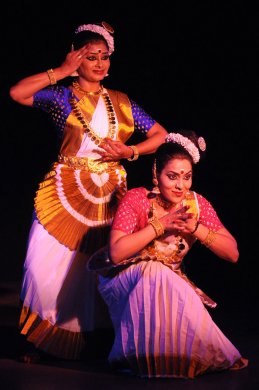
|   |

|   |
When the divine dance... through form and formless - Chandra Anand e-mail: chandra6267@yahoo.co.in Pics courtesy: NCPA September 27, 2018 God takes many forms and names in order to be available to his devotees for an experience. The formless aspect of God can be understood only when you go beyond your mind. And when you perceive 'It', the experience is of great joy. A spiritual journey is complete. On lines of this thought a new production was presented at Godrej Dance Theatre, NCPA, Mumbai on 9th September 2018 by the Tribe of Taal, an Indian dance company focused on promoting, performing and producing Indian dances. This is its very first presentation of a unique collaboration of four Indian classical dances called "When the Divine dance". The concept, a bhakti oriented one, was by Prachi Saathi. She interprets the subject of divinity with the theme of form and formless (Sagun and Nirgun). Saathi explores the idea of dancing Indian gods for 'form' and Kabir's doha for 'formless'. Here, the Divine represents both- a definitive presence through form and a mysterious energy that is formless. The performance was split in five acts.  Pooja Pant (Kathak), Saji Menon (Mohiniattam), Namrata Mehta (Odissi), Prachi Saathi (Bharatanatyam) They opened the first act, by depicting the synchronicity of all things in nature and the functioning of cosmos was likened to a dance. To mention a few examples, the rhythm in nature was depicted with pitter patter of raindrops, chirping of birds etc. Cosmos connection to the inner nature of all beings was pointed up by indicating chakras that make up the subtle body of the being. The unseen formless, the nirgun, is the soul or life form indicated by breath that builds its energy through the control of mind and concentration on chakras. The five elements of earth, air, ether, fire and water denote the gross matter of nature. These make up forms manifested in nature. The Ardhanareeswar slokam "Champeya gauradhara" by Adi Shankaracharya, was presented to denote complexities and togetherness of forms of Shiva and Parvathi. Both forms represent the extremes in nature, but their synthesis creates, sustains, stabilises, protects and annihilates the whole universe. This is shown through Bharatanatyam. It is an adapted version of the choreography by Rama Vaidyanathan. Kathak artistes joined in this presentation and presented tandava aspect and lasya aspects in forms of Shiva and Parvati. Together, maintaining their individual stylistic cadences of movement, they showed the creation by depicting flowers, peacocks, animals and the final annihilation of all bad things in the world by Shiva. The second part, presented in Mohiniattam and Odissi styles, depicted the form of Ganapathi as the dancing lord, to represent gods who dance. He dances with joyful abandon and pleases everyone around him. With utmost devotion, they depict him as the vignahartha, remover of obstacles. Here sopanam music was used. Odissi movements and gestures also were set to this music and it was well harmonized. Ganapathi slokam presented is from the ancient text Agathyam by Agastya Muni and is adapted from the original choreography by Dr. Kanak Rele. In third act, they brought out the all encompassing feminine energy of Devi. This was also performed by Mohiniattam and Odissi artists. Here Odissi music was used to introduce divine forms of Devi. Forms of Tridevi - Saraswati, Mahalakshmi and Durga was eulogised through the shloka "Namastetu mahamaye". They portrayed Devi in all her eight forms. She was extolled as the giver of intellect, showed her playing all instruments, sang and danced in praise of her. Devi in her fiery form as Kali was depicted as fearsome Bhadrakali, Kapalini, Durga, Chamundeshwari. They depicted the killing of Mahishasura and Raktabeej. Thus in her fiery form, she destroys demons to protect devotees; and when in benevolent form blesses them. Odissi took lead in this performance. Mohiniattam dancers supported well and their movements also were well synced with the Odissi music. Choreography was very picturesque and the stage was well sculpted from every angle. It was adapted from the choreography of Guru Daksha Mashruwalla. Then through Kathak, they portrayed love between Krishna and Radha. "Joolat Radhe Nathan kishore," a bandish composed by Bindadin Maharaj gave apt lyrics for them to portray Krishna and Radha. Krishna dances Raasleela and transports his beloved Radha into a transcendental state; this is the dance of passion. It is soaked in utmost madura bhava bhakti taking each of them to sublime ecstasy. They presented Vasant Panchami by depicting the drizzling rain employing tatkars. The amaad "dha ta ka thunga" was choreographed to present the onset of rains with dark clouds and lightning as visualised by the poet. Romantically, Krishna and Radha play on the swing in various ways, individually and together. Then the poet speaks of Radha and Krishna as individual forms and also of their union. Three variations of the same paran were performed to depict this. The first two variations with chakradhar were performed individually - one by Krishna and one by Radha to show their individual images. And then, together they did the third variation consisting of chakradhars, about thirty of them, circumambulating the space to show their little universe where they are two bodies but one soul. The Bharatanatyam group supported them by showing peacocks and other nature brightening the ambience of Vasant Panchami and building the divine romance of Radha and Krishna. Also they showed themselves as taking in the divine dance of Radha Krishna with bhakti. Choreography was by Rajashree Shirke and Pooja Pant.  Pooja Pant and Sarita Shirodkar For the formless, nirgun, artists took on a Kabir doha "Nirbhay gun re gaaoonga" - fearlessly will I sing praises of the formless one. He advocates the need to overcome fear, understand universal oneness and then experience the ultimate one. The explanation given was that the formless had no attributes, it's all pervading waiting to be identified and once done, the knowledge of true existence gives ultimate joy. All joined together to bring the joy of life. Artists performed a nritta item on lines of thillana. And then following Kabir's saying one goes into silence instilled in the mind by the joy experienced and into infinity denoted by letter eight. 
Prachi Saathi and Keerthana Ravi
 Saji Menon and Krishna Niddodi In this presentation four classical dances Bharatanatyam, Mohiniattam, Odissi and Kathak came together. Though the concept is by Prachi Saathi the choreography was composed by all together - Prachi Saathi and Keerthana Ravi (Bharatanatyam), Krishna Niddodi and Saji Menon (Mohiniattam), Sarita Shirodkar and Pooja Pant (Kathak), Namrata Mehta and Tamanna Tanna (Odissi). The experience and accomplishment of the artists could be gauged in their skill in amalgamating all forms to the concept. Each form stood itself independently and also worked in a cohesive manner to present the concept. Succinctly and captivatingly, all styles were synchronised to the concept very beautifully. Though each form was different from the other, they blended without any deviation or compromise on their individual styles, retaining beauty of individual dance forms as the end factor. Music for the first and last act was set by Satish Krishnamoorthy. The show was performed on recorded music. Chandra Anand is a Bharatanatyam artiste and teacher. She has an MA in Bharatanatyam from Tilak Maharashtra Vidyapeeth, and her series on 'Education in spiritual values through Bharatanatyam' is featured in narthaki.com. |